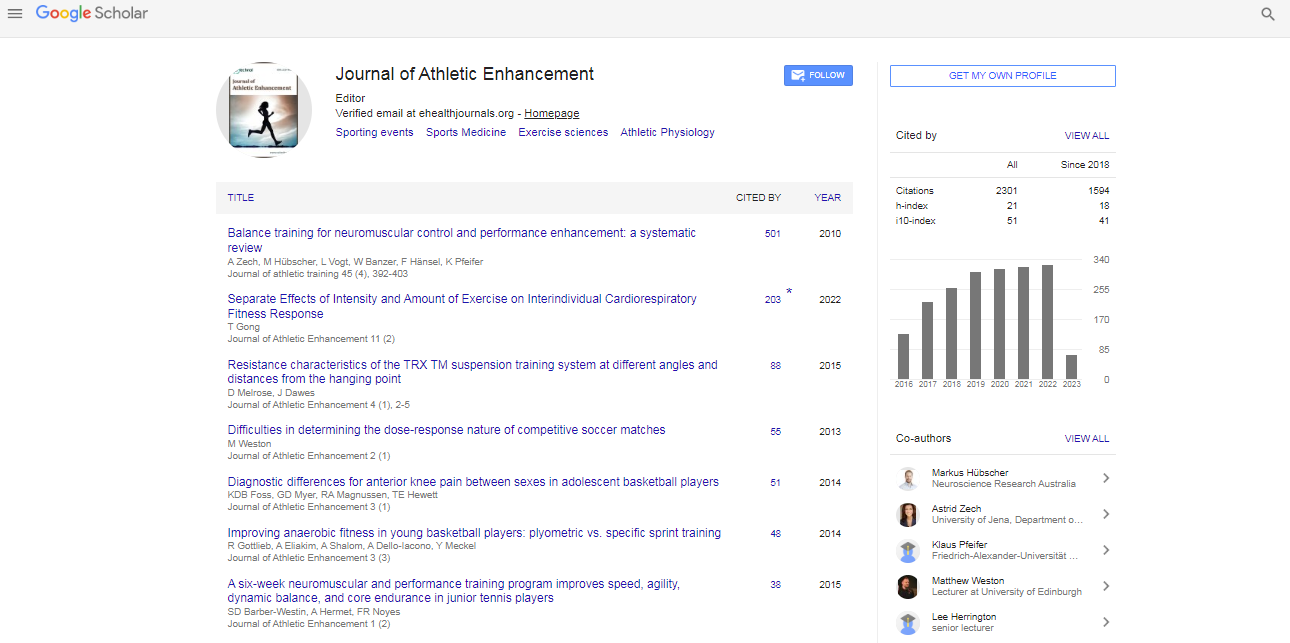Perspective, J Athl Enhanc Vol: 13 Issue: 3
Sport Concussions: It's Diagnosis and Preventing Methods
Yufei Qiu*
1Department of Sports Medicine, Fourth Medical Center of PLA General Hospital, Beijing, China
*Corresponding Author: Yufei Qiu,
Department of Sports Medicine, Fourth Medical
Center of PLA General Hospital, Beijing, China
E-mail: qiyufei@edu.cn
Received date: 26 April, 2024, Manuscript No. JAE-24-137884;
Editor assigned date: 29 April, 2024, PreQC No. JAE-24-137884 (PQ);
Reviewed date: 14 May, 2024, QC No. JAE-24-137884;
Revised date: 20 May, 2024, Manuscript No. JAE-24-137884 (R);
Published date: 27 May, 2024, DOI: 10.4172/2324-9080.1000130
Citation: Qiu Y (2024) Sport Concussions: It's Diagnosis and Preventing Methods. J Athl Enhanc 13:3.
Description
Sport-related concussions have gained increasing attention in recent years due to growing awareness of their potentially severe consequences. Concussions, often referred to as mild Traumatic Brain Injuries (mTBIs), occur frequently in various sports, posing significant challenges to athletes, coaches, healthcare professionals, and policymakers. A concussion is a traumatic brain injury induced by biomechanical forces transmitted to the head. In sports, concussions typically result from direct blows to the head, face, neck, or elsewhere on the body with an impulsive force transmitted to the head. The injury disrupts normal brain function temporarily, leading to a range of physical, cognitive, emotional, and sleep-related symptoms.
Sport-related concussions can occur in various athletic activities, including football, soccer, rugby, hockey, basketball, and combat sports. Common mechanisms of injury include player-to-player collisions, falls, impacts with equipment, and sudden deceleration. Factors such as inadequate protective gear, improper technique, and rule violations can increase the risk of concussions in sports. The symptoms of a sport concussion can vary widely among individuals and may manifest immediately or develop gradually over hours or days. Physical symptoms include headache, dizziness, nausea, vomiting, blurred vision, and sensitivity to light or noise. Cognitive symptoms encompass confusion, difficulty concentrating, memory problems, and slowed reaction times. Emotional symptoms may include irritability, sadness, anxiety, and mood swings. Sleep disturbances, such as insomnia or excessive drowsiness, are also common following a concussion.
Prompt and accurate diagnosis is crucial in managing sport concussions effectively. Healthcare professionals typically conduct a comprehensive evaluation, including a detailed medical history, neurological examination, cognitive assessment, and balance testing. Imaging studies such as Computed Tomography (CT) or Magnetic Resonance Imaging (MRI) may be ordered to rule out more severe brain injuries or complications. The management of sport concussions focuses on rest, symptom relief, gradual return to activity, and monitoring for complications. Physical and cognitive rest is recommended initially to allow the brain to heal. Medications may be prescribed to alleviate specific symptoms such as pain or nausea. Cognitive rehabilitation, vestibular therapy, and balance training may be beneficial for individuals with persistent symptoms. Graduated return-to-play protocols outline stepwise progression back to sports participation under medical supervision, minimizing the risk of reinjury or exacerbation of symptoms.
Preventing sport concussions requires a multifaceted approach involving rule changes, equipment improvements, education, and training. Sports organizations and governing bodies have implemented initiatives to reduce the risk of concussions, such as enforcing stricter penalties for illegal hits, improving helmet designs, and educating athletes, coaches, and parents about concussion recognition and management. Proper technique, strength and conditioning programs and adherence to safety guidelines are essential in mitigating the risk of injury. While most individuals recover fully from a single concussion, repeated concussions or cumulative sub-concussive impacts may lead to long-term consequences, including cognitive impairment, mood disorders, and neurodegenerative diseases such as Chronic Traumatic Encephalopathy (CTE).
Research on the long-term effects of sport concussions is ongoing, highlighting the need for continued monitoring, surveillance, and interventions to protect the brain health of athletes across their lifespan. Sport concussions represent a significant public health concern with far-reaching implications for athletes, coaches, healthcare professionals, and policymakers. By understanding the causes, symptoms, diagnosis, treatment, prevention, and long-term implications of concussions, stakeholders can work collaboratively to promote athlete safety, improve concussion management protocols, and minimize the risk of adverse outcomes. Vigilance, education, and evidence-based interventions are essential in safeguarding the wellbeing of individuals participating in sports and recreational activities.
 Spanish
Spanish  Chinese
Chinese  Russian
Russian  German
German  French
French  Japanese
Japanese  Portuguese
Portuguese  Hindi
Hindi 
